Plasterboard ceilings: design ideas for different rooms
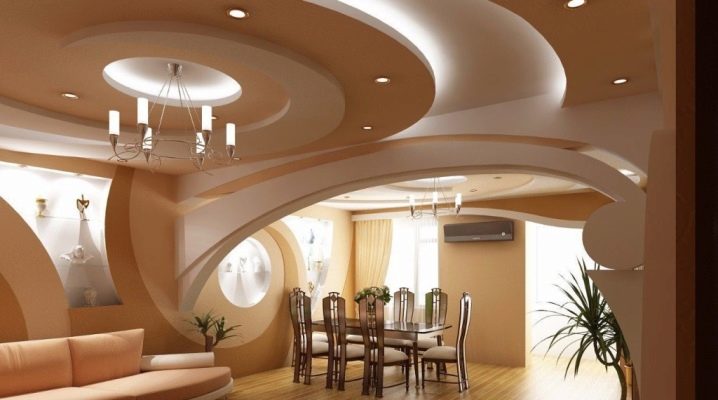
Drywall is an inexpensive and malleable material from which a wide variety of designs can be made. The large list of possible products includes attractive ceilings, which are easy to make from plasterboard sheets. Elements like these look very interesting and attractive when installed correctly. Today we will take a closer look at how plasterboard ceilings look in different rooms.
Peculiarities
Plasterboard ceiling is an excellent solution for finishing different rooms. It can consist of one, two, three or more levels. And if you equip them with high-quality lighting devices or diode lighting, then the interior of the room will become fabulous at all.






Drywall is an invaluable material for repairs. It is often used in the manufacture of light and uncomplicated cabinets, racks, shelves and even additional floors. Such multitasking of this material is due to its affordable cost and pliability. It is easy to work with it, and you can finish it in almost any way. You can paint drywall, cover with decorative plaster, and even wallpaper.






As for plasterboard ceilings, they can also be finished at your discretion, but most often a paint of a suitable color is selected for their design. Most of the dye mixtures are easy enough to fall on such a base, so the result is more often pleasing to the owners than upsetting.
Another feature of the plasterboard ceiling is that it does not need to be prepared for a long time and scrupulously before direct processing. As a rule, sheets of this material have perfectly flat surfaces that do not need to be sanded or covered with a leveling compound.


Often, multi-level plasterboard ceilings are supplemented with PVC or fabric stretch films. In a single tandem, such euro designs look very attractive and rich. Inexpensive drywall can also neatly frame a stretch ceiling on one or more sides. At the same time, built-in lighting devices can be installed both in an elastic canvas and in a multi-level rigid structure.



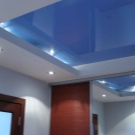

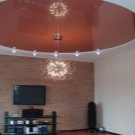
The use of such ceiling coverings is permissible in almost any room. The only exception can be a space with a high level of humidity. In such conditions, drywall will not last long, as it does not tolerate dampness and moisture well. That is why such designs are rarely used in the kitchen, sauna, pool or bathroom. If you nevertheless decide to install a plasterboard ceiling in one of the listed rooms, then you should invest in more reliable and moisture-resistant materials, which, as a rule, are not afraid of such situations.


Another feature of the plasterboard ceiling is that the rough base does not need to be thoroughly prepared before installing it. Any damage, defects and cracks in the ceiling will be reliably hidden by sheets of drywall.
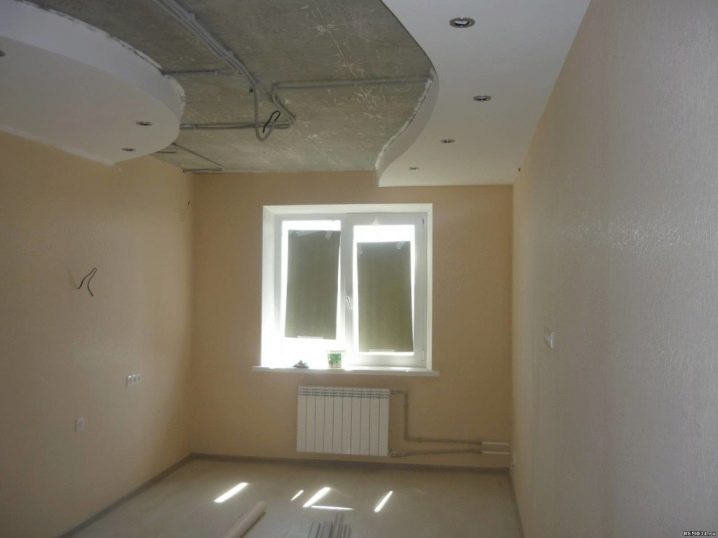
It is worth noting that drywall itself is inexpensive and easy to find.However, the total cost of a tiered ceiling, especially if it is supplemented with stretch film, can be quite high as you need a lot of special tools. And finishing materials such as paints and enamels are not cheap if they are of high quality.
You can install a plasterboard ceiling with your own hands. To do this, it is recommended to enlist an assistant, since it will be very difficult to cope with all the stages of installation work alone. However, for the manufacture of original designs of non-standard shapes, it is necessary to have the appropriate skills, otherwise a beautiful and neat ceiling model may not work. If you cannot boast of such experience, it is better to entrust this work to professionals.

Advantages and disadvantages
Original plasterboard ceilings have their own strengths and weaknesses. If you decide to install such a structure in your home, then you should definitely familiarize yourself with them.
It should be noted the absolute safety of the plasterboard structure. This material is environmentally friendly and does not contain toxic compounds. Thanks to this characteristic, this ceiling can be installed without fear even in children's rooms. Gypsum is breathable. With an excess of moisture, it absorbs it and gives it up if the air becomes too dry.

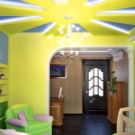




Drywall has a smooth and even surface. There are no cracks or chips on it, so such material will look great in the interior. Moreover, due to its pliability and smoothness, paint or plaster will easily apply to it.
Many consumers opt for drywall, because it has good sound and heat insulation properties. Having a ceiling made of such material, you will forget about unnecessary sounds coming from the upper floors.


With drywall, you can create amazing ceiling structures that have many levels. Such options look bright and attractive and never go unnoticed.




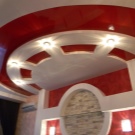

Drywall can be safely supplemented with various decorative elements. It can be exquisite baguettes, beautiful borders or luxurious stucco moldings. Such tandems will look organic in many interiors, from classic to eclectic.




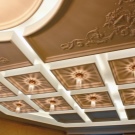

Drywall sheets are plastic. They can be bent (but not too much), having thoroughly moistened before this. Then the material must be dried and used in the creation of curved structures.
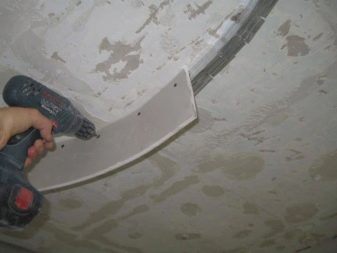



Various communications can be hidden behind the plasterboard. These can be ventilation ducts, water pipes and different types of cables. As a rule, the listed details are knocked out of the interior and spoil it, but a plasterboard ceiling will help solve this problem.
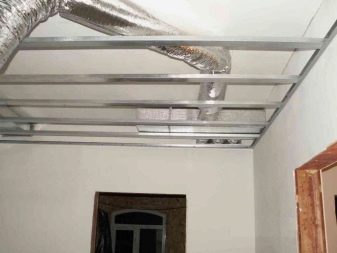



Such ceiling coverings can be fitted with different lighting fixtures. It can be not only recessed and spotlights, but also beautiful chandeliers. Of course, overweight and heavy models are best avoided, as they will put unnecessary stress on the drywall.
It is dry-installed on the ceiling base, so you do not have to wait long for the adhesive solution to dry, which can significantly save time.






Despite the large number of positive qualities, plaster ceilings have their weaknesses.
The installation of such structures reduces the height of the room (by at least 5 cm), since it has a fairly high profile. Because of this, resorting to these finishes in small rooms with low ceilings is not recommended. Otherwise, you will end up with too cramped and uncomfortable space.


Experts say that it will be very difficult for novice home craftsmen to cope with the installation of plasterboard ceilings. In this work, you cannot do without a hammer drill and a high-quality screwdriver.A good level is also important (a laser device is ideal).
- There are times when, over time, cracks appear at the joints of drywall sheets.

- Drywall is inexpensive and malleable, but quite fragile. It must be transported very carefully, and you need to be careful when working with it. If damage appears on the drywall sheet, then it will be almost impossible to get rid of it and will have to be replaced with a new one.

- Do not drive nails into drywall. Dowels or screws should be used instead. Do not expose this material to heavy loads, otherwise the drywall may begin to crumble and, as a result, simply break.

- It is almost impossible to install such structures alone, so make an appointment in advance with someone from your relatives or friends who are ready to help you in this work.

- Drywall "Does not like" high humidity in the room. In such conditions, it can undergo deformation. Of course, there are more wear-resistant types of boards that are moisture-resistant, but even they can warp if the humidity level in the room exceeds 80%.
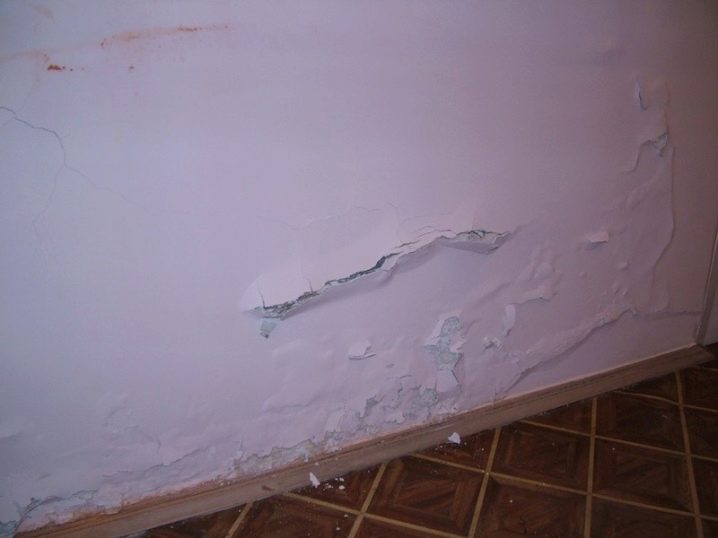
- Another disadvantage of plasterboard ceiling is that that parasites, for example, cockroaches, can start in it. This problem can hardly be called global, but in any case it is not very pleasant.

Types and designs
Plasterboard ceilings can have a wide variety of shapes and designs. Let's take a closer look at the most popular and attractive options.
Sibling
Such constructions are quite simple. They can be a ready-to-finish canvas or serve as a basis for installing the next additional levels.

A single-level ceiling is installed very quickly and easily. According to experts, even inexperienced home craftsmen can easily cope with such work. The main thing that should be taken into account during installation is the reliable fastening of the frame. This part can be made from aluminum or wood. It is attached as close to the base as possible, after which it is trimmed with sheets of gypsum.

When installing a single-level ceiling frame, you must use special measuring tools. Particular attention should be paid to the level of the ceiling - it must be in the correct horizontal position. Do not forget to think carefully about how the electrical wiring or other communication systems will go under the plaster.

Before installing drywall, you need to resolve the issue with lighting devices and make them neatly installed. The finishing touch in this case will be the finishing of the drywall itself.
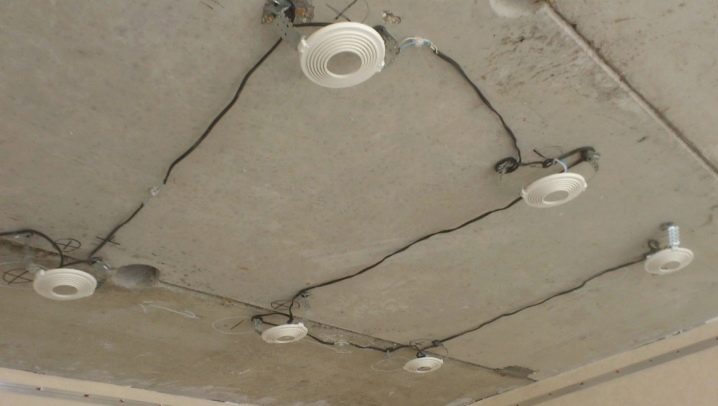
The main advantages of single-level coatings include:
- Their aesthetic appearance, which lasts for a very long time, even if the foundation of the house begins to sag.
- Uncomplicated installation process, during which the height of the room suffers the least.
- Maximum leveling of the ceiling, during which it will be possible to hide any defects and imperfections. In addition, behind such structures it is easy to hide communications and electrical wiring.
Designers recommend turning to single-level coatings in case the home cannot boast of high ceilings

Multilevel
A plaster ceiling can be made up of several levels. Such volumetric designs look much more interesting than simple single-tier options. They can consist of two, three or more tiers.


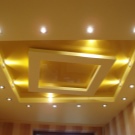



Such structures can be safely installed on concrete ceilings or a pre-created single-level ceiling. In all cases, the invariable feature of such details should be taken into account: the lower the last tier is, the less area it will have.The next level (starting from the second, of course) is not mounted on the ceiling area, but on the frame of the previous tier.
Multilevel options can be mounted independently, although this work can hardly be called very simple. In such cases, the location of each tier should be accurately calculated. In addition, they should look perfect in a single ensemble.
So, for graceful and curly options, it is worth choosing curved sheets of drywall, and for coarser geometric designs, ordinary canvases are quite suitable.


The main advantages of two- and three-level ceiling structures are:
- The ability to visually change the layout. With the correct and competent execution of all work, the resulting structure can significantly change the structure of the room, making it larger or, conversely, more compact.
- Also, multi-level ceilings look original and stylish, so they are often used in the design of modern apartments and houses.
- With the help of such structures, you can unobtrusively zoning the available space.



It should be borne in mind that multi-tiered plasterboard structures will significantly "eat up" the height of the ceiling, so they can only be used in spacious rooms with high ceilings. Otherwise, the space will be very tight and "oppressive".
Curly
If you are a lover of non-standard solutions and original interiors, then you should consider installing a curly ceiling in your home. Such designs have unusual shapes. On their surface, there may be elements in the form of flowers, butterflies or patterned lines. It is very difficult to cut drywall of this shape on your own, so it is better to entrust this work to specialists.
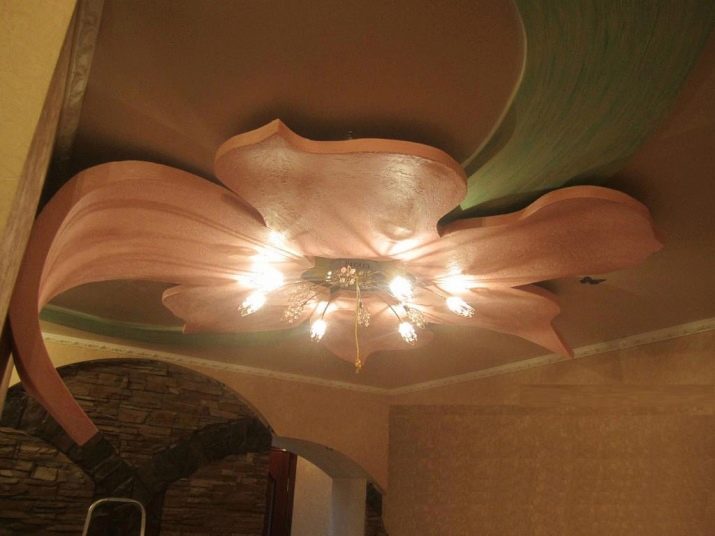





Such ceiling structures can be safely addressed in the design of both adults and children's rooms. Young households always like such design solutions, especially if they are painted in positive and pleasant colors.

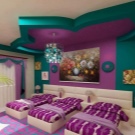




In order for the interior design with a curly ceiling to look more harmonious and organic, the shade of furniture and plasterboard should overlap with each other. Otherwise, different elements of the ensemble will conflict with each other.






Framework
Frame plasterboard ceilings are uncomplicated and uncomplicated in terms of installation. They are an ordinary box with 1-2 steps. The shape of frame structures can be not only rectangular, but also curly.






As a rule, the thickness of the box in frame versions is no more than 50 cm. This element is located along all the floors in the room and is often complemented by hidden lighting, which is an LED strip. Such a product can also be equipped with point devices in the center of the box.
Diagonal
Modern diagonal plasterboard ceilings are original and attractive. They have a perfectly flat base, and the lower levels are made so that they protrude above one side of the room or another.





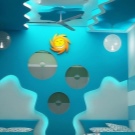
The dividing line in these instances extends diagonally (from one corner to another). It can be either simple and straight, or graceful and wavy. The last option, of course, looks much more original, but it does not fit all stylistic directions, and it is more difficult to make it.
Zonal
Today, several functional areas are often combined in one room. For example, in the conditions of a studio apartment, all the necessary elements are located at all on one, undivided area. Also, quite often the bedroom is combined with a work area, and a living room with a kitchen. In these cases, it is simply necessary to make competent zoning of the space in order to separate different areas from each other. For this, a zoned plasterboard ceiling is suitable.





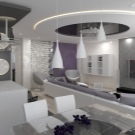
In such constructions, the second or third step defines the specific border of a particular zone. You should not be afraid of these options, since they do not take up too much free space in the room.
Abstract
These drywall products look incredibly original and futuristic. You can refer to them in the design of a modern interior. Most often, such structures have a spiral structure of an irregular shape. However, other options are quite acceptable, as well as cunning interweaving of a certain number of elements, "scattered" over the entire plane of the base.






Abstract plasterboard ceilings look more interesting when supplemented with suitable lighting fixtures. You can also add zest to the volumetric structure using paint and varnish coatings of different tones.
Soaring
Beautiful "floating" (suspended) plaster ceilings are extraordinary. In them, plasterboard parts are attached to the concrete base in an unusual way. For this, special fitting sleeves are used, as well as reliable metal pins with studs for fixing. As a result, the qualitatively fixed figures look as if they are floating in the air without any fasteners on them.



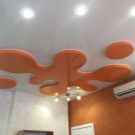


A feature of suspended soaring ceilings is that their composition can be changed from time to time. To do this, it is enough to rotate the plaster elements on the axis, forming a new composition.
Arched
Fans of luxurious and pompous interiors will definitely like the aristocratic arched ceiling, and it does not matter that it is made of inexpensive drywall. It has a graceful curved cavity that requires a lot of free space. That is why it is better to install arched structures in spacious rooms with high ceilings.



It is not easy to make such structures. In them, the sheets of drywall need not only be slightly bent, but bend quite strongly and prepare a complex frame. Not every owner will be able to cope with the installation of these copies, therefore it is better to entrust this work to professionals.
Sizes and shapes
Plasterboard ceilings can be of almost any shape, from square to graceful arch.
However, the most popular and frequently encountered are the following constructions:
- Round;
- Oval;
- Asymmetrical;
- Rectangular;
- Square;
- Wave-like.
Of course, there are also more original options. These examples include unusual curly designs. The cost of such ceilings is quite high, but with their help you can revive the interior and make it truly unique.





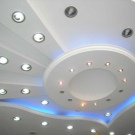
The thickness of the product largely depends on the type of drywall chosen for the manufacture of the structure:
- Arched sheets have a minimum thickness (6.5 mm). Thanks to this parameter, these materials are easy to bend and do not break at the same time.
- The width of the plaster of paris is usually about 12.5 mm. It is perfect not only for leveling floors in a room, but also for making different (more rigid) structures.
- Ceiling plasterboard has a width of 8 to 9.5 mm. This is a lightweight version of the standard sheets. Such materials are lightweight.
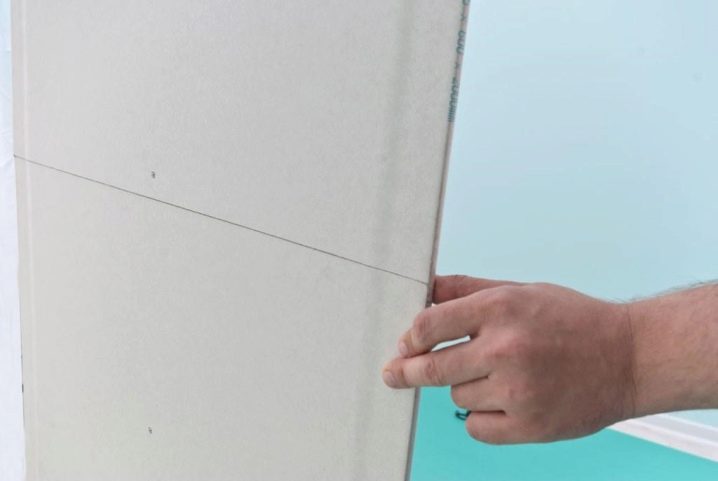
The height of the plasterboard structure, first of all, depends on the height of the ceiling in the room:
- If the height of the room is 2.5-2.7 m, then it is worth installing a small ceiling with one level.
- At a height of 3 m, you can safely install more impressive two-level structures.
- In rooms with a height exceeding 3.3 m, large plasterboard structures in 3 tiers can be installed.
Before proceeding with the manufacture or installation of a plasterboard ceiling, you should first measure all the parameters of the room. Otherwise, you run the risk of making a mistake and installing a structure that is too large, which will ruin the situation.

Style and design
The plasterboard ceiling should be not only beautiful and reliable, but also suitable for the main style of the interior. Thanks to a wide range of finishing materials, such designs can be easily adjusted to any direction. Let's take a closer look at some of the distinctive features inherent in single-level or multi-level ceilings made in different styles.
High tech
Hi-tech is a modern stylistic trend that is wildly popular. Many designers call this style “a classic of modern youth”. It is characterized by strict and laconic lines, as well as high-tech details. As for materials, in high-tech interiors, decorative elements and pieces of furniture made of glass, metal (chrome-plated or painted) or wood painted in laconic colors (black, white, dark blue) are welcome.

Plasterboard ceiling will look great in such an ensemble. It can be painted white, black, gray, dark blue. The main thing is to supplement the design with a sufficient number of lighting devices. These can be stylish LED strips, track lights with steel bases or recessed options with chrome frames.



Plaster ceilings, complemented by stretch films, look good in modern interiors. The best options will be glossy coatings in discreet colors. With the help of mirror elements, you can transform the environment, as well as create the visual effect of a more spacious room.


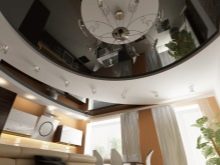
In high-tech style, it is not recommended to use a ceiling overloaded with decorative details.
Minimalism
The minimalist interior is the simplest and most uncomplicated. It should not contain many different decorative elements and pieces of furniture. It is customary to fill such spaces with the minimum number of elements (the most necessary).

In minimalistic ensembles, you can safely use plasterboard ceilings, however, you should not build multi-tiered structures with unusual details. The cover should have the simplest look possible, not weighted down with decor or graceful strokes. This also applies to lighting fixtures. It is better to refuse lush ceiling chandeliers with volumetric shades. Give preference to spotlights. The use of an LED strip is acceptable.



Classic
Classics are a style that will never go out of style. Interiors in this vein are found quite often, because they look elegant and expensive, while maintaining a restrained and rather strict image.

In such interiors, multi-level ceilings can be used, despite the widespread belief that they are intended only for futuristic and modern trends. In a classic ensemble, you can install a beautiful design with baguette inserts and several levels. Of course, multi-tiered options should be addressed only if the area of the room allows it.



In classic and neoclassical interiors, complex arched and curly ceilings look organically. Such options are never disregarded and make the furnishings more expensive and solid. However, it is worth considering that such structures are not cheap and are not easy to install.

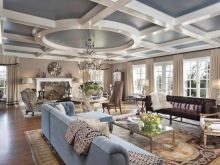

Also, in a classic ensemble, a multi-level ceiling with stucco will look great. An interior with such details will become a real work of art. However, there should not be too many stucco details, otherwise the structure will seem too heavy and tasteless.
Modern
This style is characterized by graceful and flowing lines, as well as natural materials that combine with high-tech. There are no strict rules regarding interior design in this direction.




Thus, a plaster suspended ceiling in a modernist interior can be a laconic circle, an angular or asymmetrical square with beautiful patterns and a graceful wave. The specimens look interesting, complemented in the central part by a woven insert and a large pendant chandelier. This solution looks original, elegant and fresh.
The color of the plasterboard structure can be almost any, but in the Art Nouveau style, specimens of white, beige, cream, light caramel and milk shades most often find their place. They are not striking and do not draw all the attention to themselves.



Vintage
This is another popular style, distinguished by its mysteriousness and unique image. More recently, it was considered not universal and even to some extent an avant-garde direction, but the latest fashion trends have broken previous stereotypes, so vintage has become a popular and relevant trend.




In interiors made in such an interesting way, beautiful ceilings in several tiers can be used. You should not avoid LED strips and various decorative details. Oddly enough, these elements look quite good in vintage settings.
Curly ceilings are classics of the vintage style. Such copies are expensive and not so easy to install. If all actions were performed correctly, the design will surely fit well into the vintage ensemble and emphasize its uniqueness. It may contain graceful wavy lines or elements of original shapes (for example, a large flower).



Plasterboard ceilings in vintage interiors can be complemented by chic antique-styled chandeliers. Such a beautiful and effective detail should be beaten with matching skirting boards. The result is a rich and luxurious environment.



Art Deco
A style like Art Deco is distinguished by its special luxury and unique elegance. Interiors in a similar vein, with all their appearance, demonstrate the chic and splendor of the home, as well as the unsurpassed taste of its owners. Many people are sure that this direction does not accept the use of inexpensive drywall. In fact, this is not the case.


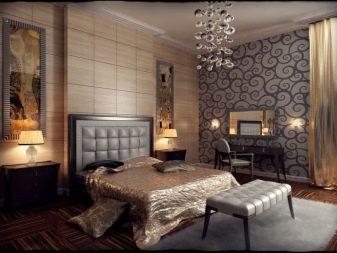

Of course, ordinary single-tiered gypsum ceilings in such ensembles will be inappropriate, but complex multi-level options, decorated with beautiful lighting, will be successful solutions.
You should not paint the plasterboard ceiling in a simple white color, but it is better to avoid too variegated and bold colors. Surfaces in beige, cream, brown or pastel shades are ideal. Such elements will unobtrusively emphasize the interior, without getting out of its basic concept.

In Art Deco settings, you can use combined ceilings where the drywall collides with the stretch film. To compose a more harmonious and elegant ensemble, you should turn to glossy coatings, which, being in a plaster box, will look especially interesting and bright. It is worth noting that these beautiful details will be an effective addition to both small and large rooms.



As for lighting fixtures, luxurious chandeliers with graceful pendants will look best in the art deco style. Another great design technique will be stucco molding on the ceiling.
Loft
Loft is another popular modern style that is brutal, lightly rude and industrial touches. In such ensembles, elements from concrete, metal, brick and stone look great. The use of wood is acceptable. It can be either processed or aged (with knots and splinters).

Such interiors can be made more effective and harmonious., and drywall will certainly help with this.A small two-level or one-level plaster ceiling can be finished with a variety of paints, and it is not at all necessary to achieve a perfectly even and neat coating. Small stains and roughness will give the structure an interesting texture that is perfect for a loft style.



In most cases, they try to carefully cover up all the joints on the plaster ceiling so as not to spoil the appearance of the interior. In an environment made in the direction of the loft, this work is not necessary at all. Quite often, on the contrary, they try to emphasize the tiny gaps between the sheets in order to give the designs an authenticity.
Lighting
Gypsum ceilings (both single-level and multi-level) can and should be supplemented with various lighting fixtures. The following options are best for this:
- LED strips. Most often they are hidden behind a box, so they are practically invisible when looking at the ceiling, but the light that they emit is visible. Today in stores there are diode strips of different colors, and some of them combine all the colors that can be controlled using the remote control.

- Spotlights. These lighting fixtures are most often used in the decoration of plaster and stretch ceilings. They are very easy to install, last a long time and look organic in any interior.

- Track. Such lighting devices are primarily intended for modern interior styles. They usually have black or white painted metal and steel bases. There are also chrome-plated copies.
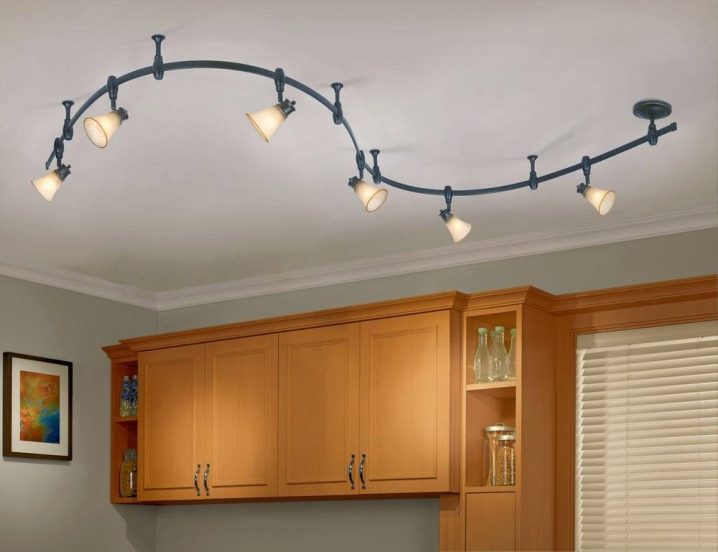
- Chandeliers. Luxurious and lush chandeliers can also be installed in plaster ceilings. Of course, overly heavy devices are best avoided, since plaster is not designed for too heavy loads. Ceiling chandeliers look especially organic in classic, vintage and artsy interiors.

- Pendant lights. Small pendant lights look great in many interiors. They can have neat glass or crystal pendants. Such models weigh a little, so they do not create loads on drywall.

Care Tips
Plasterboard ceilings are not demanding. They do not need specialized and complex care with many expensive cleaning products.
In order for the design to last as long as possible and maintain an attractive appearance, the following nuances should be taken into account:
- In no case should gypsum ceilings be washed and moistened abundantly, because drywall does not tolerate water. Under such influence, it can deform, and then no repair can fix it. Water can only be used (in moderation) if your ceiling is made of the more expensive, durable, moisture-resistant gypsum.
- Cleaning of the coating must be extremely dry.
- If dust and other minor dirt accumulates on the surface of the ceiling, then you can use a slightly damp and well-wrung out cloth with a soft bristle. It is not necessary to rub the material hard, with pressure, because it is quite fragile.
- If a crack or chip has formed on the plasterboard, then it will no longer be possible to fix it. First, the damaged part must be removed and then replaced with a new one.

Beautiful examples and options
Plasterboard ceiling can be used in almost any setting. The main thing is to pay due attention to its competent installation and, of course, the quality of the selected materials.
The snow-white plaster ceiling is universal. It can be a multi-level hanging structure, installed above a luxurious bar counter in chocolate shade, as well as an expensive headset made in the same color. Spotlights and chrome details (chandelier and hood) will look spectacular in such an interior. It is worth laying on the floor a glossy tile of a soft beige shade.

Lovers of luxurious interiors often turn to arched ceilings, but few people know that they can be used in a narrow corridor. Such designs can consist of several tiers, framed by spotlights. The use of LED strip in this case is only welcome. However, these products can only be installed in corridors with high ceilings.
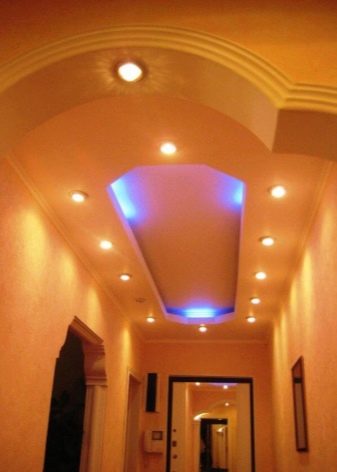

Plasterboard ceiling can also be used in a wooden house. In such an environment, structures finished with clapboard, laminate or natural wood panels will look good. If you like contrasts, then gypsum can be painted white or combined with sheets of different colors (for example, white with orange).


Gypsum volumetric coatings look good in the bay window area. It can be a cozy living room with high window openings, a lush crystal chandelier on the ceiling and a fireplace decorated with beautiful reliefs. In such a rich environment, drywall, complemented by aristocratic stucco molding, will look best.

In the bay window, an oval two-level ceiling with a bronze or wrought iron chandelier and spotlights around the perimeter will also look good. A wooden lacquered table and chairs will find their place under it, as well as blackout curtains and light tulle on the windows.

Gypsum ceilings look great in combination with stretch canvases. For example, one part of the base may consist of a snow-white plaster of Paris with a recess and recessed fixtures, and the other part of a PVC film with a glossy surface of a pale pink shade. It should be supplemented with a scattering of spotlights. Such a delicate ceiling will be a successful completion of the interior, made in white and purple colors.

Plasterboard ceilings are often installed in the attic. As a rule, the ideas of such a design are quite simple: the design in them is a perfectly flat (inclined or straight) and one-layer part. It can be supplemented not only with recessed and spotlights, but also with decorative wooden beams, stretch PVC films and even vinyl stickers. It all depends solely on the personal preferences of the owners.




A plaster ceiling made up of several small levels can be used in kitchen furnishings (if the plaster is waterproof). Its design can repeat and frame the shape of a kitchen set. For example, a snow-white ceiling will look great over glossy milky furniture with rounded doors. Spotlights should be installed in both the headset and drywall.

You can see the unusual design of ceilings in this video.













The comment was sent successfully.